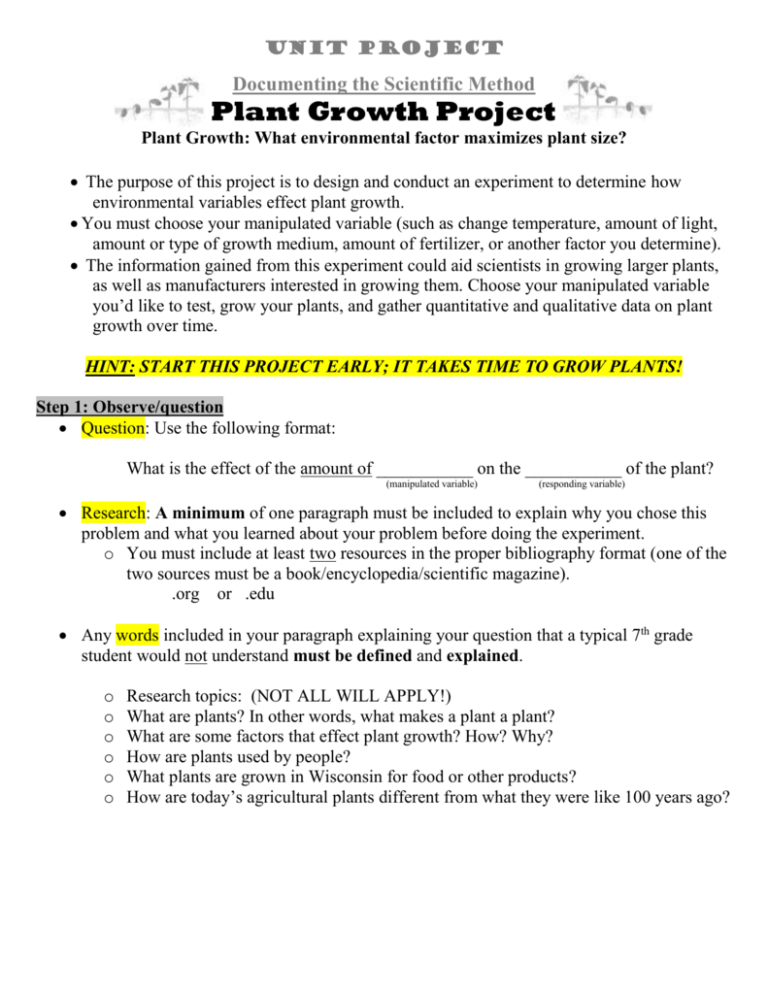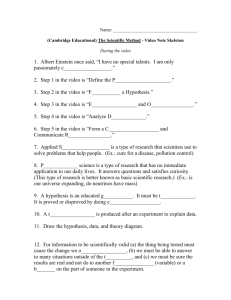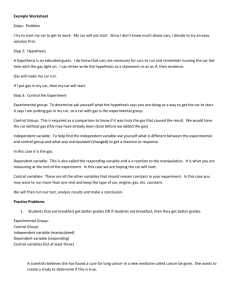Documenting the Scientific Method
advertisement

Unit Project Documenting the Scientific Method Plant Growth Project Plant Growth: What environmental factor maximizes plant size? The purpose of this project is to design and conduct an experiment to determine how environmental variables effect plant growth. You must choose your manipulated variable (such as change temperature, amount of light, amount or type of growth medium, amount of fertilizer, or another factor you determine). The information gained from this experiment could aid scientists in growing larger plants, as well as manufacturers interested in growing them. Choose your manipulated variable you’d like to test, grow your plants, and gather quantitative and qualitative data on plant growth over time. HINT: START THIS PROJECT EARLY; IT TAKES TIME TO GROW PLANTS! Step 1: Observe/question Question: Use the following format: What is the effect of the amount of ___________ on the ___________ of the plant? (manipulated variable) (responding variable) Research: A minimum of one paragraph must be included to explain why you chose this problem and what you learned about your problem before doing the experiment. o You must include at least two resources in the proper bibliography format (one of the two sources must be a book/encyclopedia/scientific magazine). .org or .edu Any words included in your paragraph explaining your question that a typical 7th grade student would not understand must be defined and explained. o o o o o o Research topics: (NOT ALL WILL APPLY!) What are plants? In other words, what makes a plant a plant? What are some factors that effect plant growth? How? Why? How are plants used by people? What plants are grown in Wisconsin for food or other products? How are today’s agricultural plants different from what they were like 100 years ago? Step 2: Hypothesis Write a GOOD hypothesis that predicts the answer to your project question using your research. Remember, a good hypothesis is SPECIFIC, testable/measureable, predicts what will happen, and written as a definite statement (don’t use weak/passive phrases such as “it might…”, “I think…” or “maybe…”). Use the following format to write your hypothesis: If the amount of ____________________ increases/decreases, then the (manipulated variable) (choose one) _______________ plant will increases/decreases. (responding variable) (choose one) In a paragraph under your stated hypothesis, describe how you will test your hypothesis by doing the following: o Identify the manipulated (independent) variable and three different increments (amounts) by which you will change it. o You will also identify the plant that did not receive the manipulated variable. “Standard of Comparison” o Identify the responding (dependent) variable. o Identify the multiple controlled variables (four to five) that you will keep the same for each trial. Step 3: Experiment This step includes growing the plants, collecting data, graphing the data, analyzing the data and reporting what happened. The report that describes what happens is called the “write-up”. Note: Take pictures or video during your experiment. This is required and is part of the next steps. ********* Remember to start this section early so you have time to grow plants! 1. Make a bulleted list of the materials needed for the experiment. - use METRIC measurements 2. Write a step by step procedure on what you will do in your experiment. - Write this like a recipe, numbering each step. - Be as concise as possible, writing clear directions. - This needs to be so detailed that another scientist could repeat your steps and get the same results as you did. This is called verifying your results. - Step 1: Gather the materials needed. - Read over your procedure to make sure it makes sense! *** Draw a labeled diagram of the experimental set up. 3. Make four data tables to record the daily information that will be gathered so the data is organized. (One table for the comparison and three tables for each plant receiving the manipulate variable.) Plant A – State MV Amount Date (Day 0 is first day planting) Quantitative Data (RV) Qualitative data Write observations here. 4. Begin the experiment. The first day of the experiment is “day 0” and responding variable will be “0”. 5. At the end of the experiment, make graph(s) of the quantitative data collected. - Use proper graphing procedures! Refer to the bookmark previously handed out. Step 4: Evaluate Type a couple paragraphs that thoroughly and thoughtfully answer the questions below by evaluating your hypothesis and experiment. Don’t forget to cite your experiment by including specific data directly from your data tables when writing your evaluation. Discuss/review the manipulated, responding, and controlled variables again. What was the average of each plant’s responding variable? Which variables did you try to control or should have controlled but could not due to your non-lab setting? What effect could that have had on your experiment results? Does your data support your hypothesis? Cite specific data directly from the data tables why the hypothesis was/was not supported. Why do you think this happened? Why did you get the results you did? What did you find out/learn from this experiment? Be specific and detailed and describe MULTIPLE things you learned. o Bad example: I learned about plants. o Better example: I learned that plants grow taller when… o Now, you write an AWESOME example. What would you do differently/change if you would do this all over again? o Bad example: “I would change my hypothesis to be correct.” o Better example: Think about the process. What could you do differently to improve the project and/or make it more effective? Now that you have new knowledge and experience from doing this project, how can you use this to come up with a NEW question about this topic? What future things would you like to test related to this new question? How could your findings be useful to farmers, botanists, horticulturists or gardeners? Step 5: Communicate This is a full-class presentation. Remember, this is a BRIEF summary of your project (2-3 minutes)! You MUST have visuals! The more visuals, the better! This includes Power Points, Proficient posters, and tangible materials to display/show. Your presentation should include a brief introduction and conclusion and also follow the scientific method. Explain what you have done for each step of the scientific method. How are you assessed? USE THE RUBRIC to ensure you are working on all items in the “proficient” column! This column is on the back of this page for your reference. Presentation Content Introduction – specific description of why project was chosen, unique and personal; grabbed audience attention Outline (Research) – shares multiple facts from research; important, relevant to question, and interesting; specific facts/concepts Hypothesis – shares hypothesis, variables, and the research behind it Experiment – shares overview of procedure, including a discussion of data/outcome in an easy to understand format Evaluation - shares a complete and thoughtful analysis of data, including specific data, how it compares to hypothesis, and why this result may have happened Conclusion – wraps everything together, includes an important concept/fact for audience to remember – unique/creative Visual and Documentation Visual aides were colorful and clear, done with best effort - important and applicable to the project; supports and enhances presentation in a creative and engaging way, organized in an easy-to-follow format. Presented at an appropriate time for an appropriate length of time. Presentation Skills Individual used frequent eye contact when speaking, voice was loud and clear, and at an easy-to-understand pace and tone portrays interest in topic. Minimal to no distracting actions throughout the presentation. Presentation Organization, Flow, and Professionalism Was clean, engaging, and productive, capturing the interest of the audience; maintained this throughout the entire presentation. Topics flowed easily in the order of the scientific method. Practice and preparation were evident. Time about 2-3 minutes. Presented like a scientist to a scientist; no gum.








